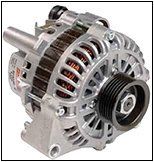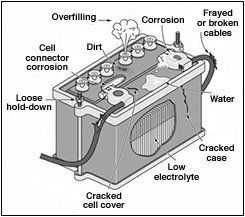Family Owned & Operated Since 1981
ELECTRICAL SYSTEMS
VEHICLE ELECTRICAL SYSTEMS
Modern auto electrical systems demand lots of electric current. High energy headlights, heated mirrors, heated seats, rear window defrosters, power windows, power seats, powerful stereo systems and multiple computers all demand power. The battery and alternator are at the heart of the electrical system.
Alternator
The alternator produces the electrical current to operate all the vehicle’s electrical devices and the current to charge the battery. A 1975 Mercedes 280SL used a 55 amp alternator and a 2006 SL500 uses a 150 amp alternator. The alternator produces alternating current which is then converted into direct current because all modern automobile electrical systems are a 12 volt DC system. The alternator is driven by a belt connected to the engine’s crankshaft pulley. The most common cause of an alternator not working is a broken drive belt.
The two main parts of an alternator are the stator and the rotor. The stator is made up of three sets of wire windings and is mounted in the alternator housing. The rotor is an electromagnet that spins inside the stator and generates an electrical current. There are two diodes connected to each of the stator windings to convert the AC current to DC. If one of the stator windings fails or one of the diodes fails, the alternator will only produce 2/3 of its normal output. The alternator is constantly spinning on two bearings and these may eventually wear out. This will produce a growling sound when the engine is running.
Most alternator problems require replacement with a rebuilt unit.

Battery
Automotive batteries are lead acid batteries which produce voltage and deliver current. They are made up of six cells, each producing 2.1 volts for a total full charge of 12.6 volts. Batteries are rated by cold cranking amps (CCA) which represent the current the battery can produce for 30 seconds at 0 degrees before the battery drops below 7.2 volts. The average rating for a battery today is about 500 CCA. The other battery rating is Reserve Capacity (RC). This measures the number of minutes that a battery at 80 degrees F can be discharged at 25 amps and maintain a voltage of 10.5 volts. The higher the RC rating, the longer the vehicle will operate if the alternator fails. If the vehicle sits for a number of days or a few weeks without being driven and the battery goes dead, this may be the result of a low reserve capacity battery.
Causes of premature battery failure are:
- Deep discharge (leaving lights on)
- Undercharging or loose alternator belt
- Excessive jarring or vibration due to loose or missing hold-down.
More than 30% of vehicles having batteries 3 years old or older experience battery failure. On average, batteries used in colder climates last longer than those used in warmer climates.

Find Us
Denver, CO 80222
Addison Auto Center
Complete Auto Repair, Service & Maintenance. Complete Collision Repair & Body Shop.
Resources
Stay Connected
All Rights Reserved | Addison Auto Center | Privacy Policy | Accessibility Statement
